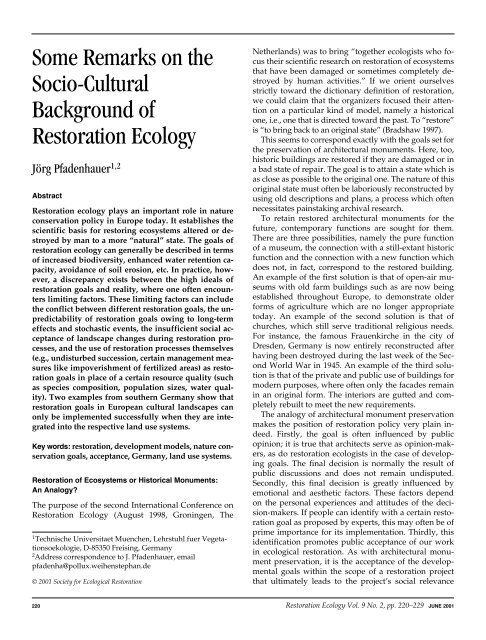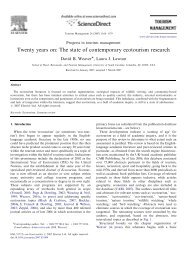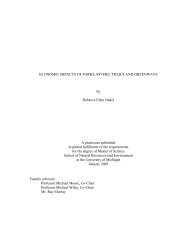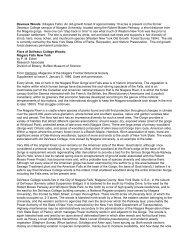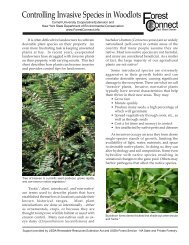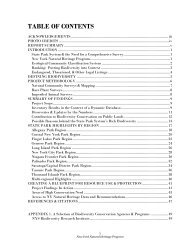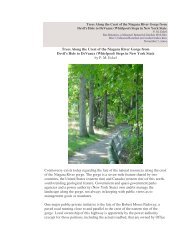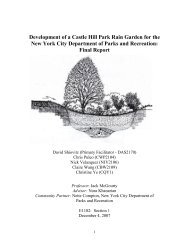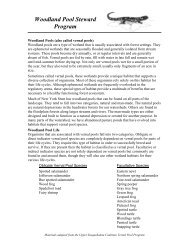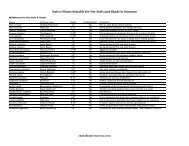Some Remarks on the Socio-Cultural Background of Restoration ...
Some Remarks on the Socio-Cultural Background of Restoration ...
Some Remarks on the Socio-Cultural Background of Restoration ...
Create successful ePaper yourself
Turn your PDF publications into a flip-book with our unique Google optimized e-Paper software.
<str<strong>on</strong>g>Some</str<strong>on</strong>g> <str<strong>on</strong>g>Remarks</str<strong>on</strong>g> <strong>on</strong> <strong>the</strong><br />
<strong>Socio</strong>-<strong>Cultural</strong><br />
<strong>Background</strong> <strong>of</strong><br />
Restorati<strong>on</strong> Ecology<br />
Jörg Pfadenhauer 1,2<br />
Abstract<br />
Restorati<strong>on</strong> ecology plays an important role in nature<br />
c<strong>on</strong>servati<strong>on</strong> policy in Europe today. It establishes <strong>the</strong><br />
scientific basis for restoring ecosystems altered or destroyed<br />
by man to a more “natural” state. The goals <strong>of</strong><br />
restorati<strong>on</strong> ecology can generally be described in terms<br />
<strong>of</strong> increased biodiversity, enhanced water retenti<strong>on</strong> capacity,<br />
avoidance <strong>of</strong> soil erosi<strong>on</strong>, etc. In practice, however,<br />
a discrepancy exists between <strong>the</strong> high ideals <strong>of</strong><br />
restorati<strong>on</strong> goals and reality, where <strong>on</strong>e <strong>of</strong>ten encounters<br />
limiting factors. These limiting factors can include<br />
<strong>the</strong> c<strong>on</strong>flict between different restorati<strong>on</strong> goals, <strong>the</strong> unpredictability<br />
<strong>of</strong> restorati<strong>on</strong> goals owing to l<strong>on</strong>g-term<br />
effects and stochastic events, <strong>the</strong> insufficient social acceptance<br />
<strong>of</strong> landscape changes during restorati<strong>on</strong> processes,<br />
and <strong>the</strong> use <strong>of</strong> restorati<strong>on</strong> processes <strong>the</strong>mselves<br />
(e.g., undisturbed successi<strong>on</strong>, certain management measures<br />
like impoverishment <strong>of</strong> fertilized areas) as restorati<strong>on</strong><br />
goals in place <strong>of</strong> a certain resource quality (such<br />
as species compositi<strong>on</strong>, populati<strong>on</strong> sizes, water quality).<br />
Two examples from sou<strong>the</strong>rn Germany show that<br />
restorati<strong>on</strong> goals in European cultural landscapes can<br />
<strong>on</strong>ly be implemented successfully when <strong>the</strong>y are integrated<br />
into <strong>the</strong> respective land use systems.<br />
Key words: restorati<strong>on</strong>, development models, nature c<strong>on</strong>servati<strong>on</strong><br />
goals, acceptance, Germany, land use systems.<br />
Restorati<strong>on</strong> <strong>of</strong> Ecosystems or Historical M<strong>on</strong>uments:<br />
An Analogy?<br />
The purpose <strong>of</strong> <strong>the</strong> sec<strong>on</strong>d Internati<strong>on</strong>al C<strong>on</strong>ference <strong>on</strong><br />
Restorati<strong>on</strong> Ecology (August 1998, Gr<strong>on</strong>ingen, The<br />
1<br />
Technische Universitaet Muenchen, Lehrstuhl fuer Vegetati<strong>on</strong>soekologie,<br />
D-85350 Freising, Germany<br />
2 Address corresp<strong>on</strong>dence to J. Pfadenhauer, email<br />
pfadenha@pollux.weihenstephan.de<br />
© 2001 Society for Ecological Restorati<strong>on</strong><br />
Ne<strong>the</strong>rlands) was to bring “toge<strong>the</strong>r ecologists who focus<br />
<strong>the</strong>ir scientific research <strong>on</strong> restorati<strong>on</strong> <strong>of</strong> ecosystems<br />
that have been damaged or sometimes completely destroyed<br />
by human activities.” If we orient ourselves<br />
strictly toward <strong>the</strong> dicti<strong>on</strong>ary definiti<strong>on</strong> <strong>of</strong> restorati<strong>on</strong>,<br />
we could claim that <strong>the</strong> organizers focused <strong>the</strong>ir attenti<strong>on</strong><br />
<strong>on</strong> a particular kind <strong>of</strong> model, namely a historical<br />
<strong>on</strong>e, i.e., <strong>on</strong>e that is directed toward <strong>the</strong> past. To “restore”<br />
is “to bring back to an original state” (Bradshaw 1997).<br />
This seems to corresp<strong>on</strong>d exactly with <strong>the</strong> goals set for<br />
<strong>the</strong> preservati<strong>on</strong> <strong>of</strong> architectural m<strong>on</strong>uments. Here, too,<br />
historic buildings are restored if <strong>the</strong>y are damaged or in<br />
a bad state <strong>of</strong> repair. The goal is to attain a state which is<br />
as close as possible to <strong>the</strong> original <strong>on</strong>e. The nature <strong>of</strong> this<br />
original state must <strong>of</strong>ten be laboriously rec<strong>on</strong>structed by<br />
using old descripti<strong>on</strong>s and plans, a process which <strong>of</strong>ten<br />
necessitates painstaking archival research.<br />
To retain restored architectural m<strong>on</strong>uments for <strong>the</strong><br />
future, c<strong>on</strong>temporary functi<strong>on</strong>s are sought for <strong>the</strong>m.<br />
There are three possibilities, namely <strong>the</strong> pure functi<strong>on</strong><br />
<strong>of</strong> a museum, <strong>the</strong> c<strong>on</strong>necti<strong>on</strong> with a still-extant historic<br />
functi<strong>on</strong> and <strong>the</strong> c<strong>on</strong>necti<strong>on</strong> with a new functi<strong>on</strong> which<br />
does not, in fact, corresp<strong>on</strong>d to <strong>the</strong> restored building.<br />
An example <strong>of</strong> <strong>the</strong> first soluti<strong>on</strong> is that <strong>of</strong> open-air museums<br />
with old farm buildings such as are now being<br />
established throughout Europe, to dem<strong>on</strong>strate older<br />
forms <strong>of</strong> agriculture which are no l<strong>on</strong>ger appropriate<br />
today. An example <strong>of</strong> <strong>the</strong> sec<strong>on</strong>d soluti<strong>on</strong> is that <strong>of</strong><br />
churches, which still serve traditi<strong>on</strong>al religious needs.<br />
For instance, <strong>the</strong> famous Frauenkirche in <strong>the</strong> city <strong>of</strong><br />
Dresden, Germany is now entirely rec<strong>on</strong>structed after<br />
having been destroyed during <strong>the</strong> last week <strong>of</strong> <strong>the</strong> Sec<strong>on</strong>d<br />
World War in 1945. An example <strong>of</strong> <strong>the</strong> third soluti<strong>on</strong><br />
is that <strong>of</strong> <strong>the</strong> private and public use <strong>of</strong> buildings for<br />
modern purposes, where <strong>of</strong>ten <strong>on</strong>ly <strong>the</strong> facades remain<br />
in an original form. The interiors are gutted and completely<br />
rebuilt to meet <strong>the</strong> new requirements.<br />
The analogy <strong>of</strong> architectural m<strong>on</strong>ument preservati<strong>on</strong><br />
makes <strong>the</strong> positi<strong>on</strong> <strong>of</strong> restorati<strong>on</strong> policy very plain indeed.<br />
Firstly, <strong>the</strong> goal is <strong>of</strong>ten influenced by public<br />
opini<strong>on</strong>; it is true that architects serve as opini<strong>on</strong>-makers,<br />
as do restorati<strong>on</strong> ecologists in <strong>the</strong> case <strong>of</strong> developing<br />
goals. The final decisi<strong>on</strong> is normally <strong>the</strong> result <strong>of</strong><br />
public discussi<strong>on</strong>s and does not remain undisputed.<br />
Sec<strong>on</strong>dly, this final decisi<strong>on</strong> is greatly influenced by<br />
emoti<strong>on</strong>al and aes<strong>the</strong>tic factors. These factors depend<br />
<strong>on</strong> <strong>the</strong> pers<strong>on</strong>al experiences and attitudes <strong>of</strong> <strong>the</strong> decisi<strong>on</strong>-makers.<br />
If people can identify with a certain restorati<strong>on</strong><br />
goal as proposed by experts, this may <strong>of</strong>ten be <strong>of</strong><br />
prime importance for its implementati<strong>on</strong>. Thirdly, this<br />
identificati<strong>on</strong> promotes public acceptance <strong>of</strong> our work<br />
in ecological restorati<strong>on</strong>. As with architectural m<strong>on</strong>ument<br />
preservati<strong>on</strong>, it is <strong>the</strong> acceptance <strong>of</strong> <strong>the</strong> developmental<br />
goals within <strong>the</strong> scope <strong>of</strong> a restorati<strong>on</strong> project<br />
that ultimately leads to <strong>the</strong> project’s social relevance<br />
220 Restorati<strong>on</strong> Ecology Vol. 9 No. 2, pp. 220–229 JUNE 2001
<strong>Socio</strong>-<strong>Cultural</strong> <strong>Background</strong> <strong>of</strong> Restorati<strong>on</strong> Ecology<br />
and hence legitimacy. Fourthly, new buildings corresp<strong>on</strong>ding<br />
to <strong>the</strong> modern requirements can also become<br />
architectural m<strong>on</strong>uments worthy <strong>of</strong> protecti<strong>on</strong> perhaps<br />
in 50 or 100 years; we cannot exclude <strong>the</strong> possibility that<br />
<strong>the</strong>y will be <strong>of</strong> high importance in <strong>the</strong> future as part <strong>of</strong><br />
<strong>the</strong> heritage <strong>of</strong> this century. In <strong>the</strong> same way, newly created<br />
sites can <strong>of</strong>fer good living c<strong>on</strong>diti<strong>on</strong>s for <strong>the</strong> survival<br />
<strong>of</strong> many species (Bradshaw & Chadwick 1980) as<br />
can be seen by <strong>the</strong> example <strong>of</strong> open-cast brown coal<br />
mining pits in Central Europe (Mahn & Tischew 1995;<br />
Tischew & Mahn 1998).<br />
It is interesting to note that <strong>the</strong> majority <strong>of</strong> restorati<strong>on</strong><br />
projects in Europe are c<strong>on</strong>cerned with <strong>the</strong> restorati<strong>on</strong> <strong>of</strong><br />
a historic state (Klötzli 1991). The first questi<strong>on</strong> is most<br />
critical: Must we restore to historic systems in every<br />
case, or be guided by more general nature c<strong>on</strong>servati<strong>on</strong><br />
policies? There are c<strong>on</strong>flicts in goals <strong>of</strong> nature c<strong>on</strong>servati<strong>on</strong><br />
in general, as well as those related to <strong>the</strong> target<br />
state for restorati<strong>on</strong> projects. This includes <strong>the</strong> sec<strong>on</strong>d<br />
questi<strong>on</strong> <strong>of</strong> whe<strong>the</strong>r management can really influence<br />
<strong>the</strong> target state or <strong>on</strong>ly <strong>the</strong> target process. Last but not<br />
least, we must search for ways that lead to developing a<br />
nature c<strong>on</strong>servati<strong>on</strong> strategy in order to gain sociopolitical<br />
acceptance <strong>on</strong> <strong>the</strong> <strong>on</strong>e hand, and maximize efficiency<br />
<strong>on</strong> <strong>the</strong> o<strong>the</strong>r (Clark 1997).<br />
Developmental Models: Forward Looking or Buried in<br />
<strong>the</strong> Past?<br />
Many ecosystems in European cultural landscapes (as<br />
defined by Naveh 1998) which are highly rated today<br />
are <strong>the</strong> products <strong>of</strong> pre-industrial land use systems.<br />
These include all forms <strong>of</strong> poor grassland <strong>on</strong> moist and<br />
dry soils, dwarf shrub and mire heaths, open forests<br />
and park-like structured landscapes, as well as <strong>the</strong><br />
plant cover in villages with a range <strong>of</strong> traditi<strong>on</strong>al herbs<br />
and medicinal plants. Over millennia <strong>of</strong> human use, until<br />
<strong>the</strong> introducti<strong>on</strong> <strong>of</strong> mineral fertilizati<strong>on</strong>, a trophic<br />
gradient developed in landscapes dominated by agricultural<br />
land use. Organic material (like litter) was collected<br />
from <strong>the</strong> periphery, <strong>the</strong> outfields (in German Allmende)<br />
and was applied as fertilizer to arable land in <strong>the</strong><br />
immediate vicinity <strong>of</strong> <strong>the</strong> villages (<strong>the</strong> infields), ei<strong>the</strong>r<br />
directly or after having been strewn in animal sheds.<br />
Owing to <strong>the</strong> c<strong>on</strong>tinuous removal <strong>of</strong> nutrients, <strong>the</strong> soils<br />
<strong>of</strong> <strong>the</strong>se outfields became poorer and subject to erosi<strong>on</strong><br />
<strong>on</strong> steep sites (caused by heavy rainfalls particularly<br />
during <strong>the</strong> sec<strong>on</strong>d half <strong>of</strong> <strong>the</strong> fourteenth century; Bork<br />
et al. 1998), while <strong>the</strong> forests degraded into open,<br />
stunted stands. This situati<strong>on</strong> is clearly recognizable in<br />
<strong>the</strong> images <strong>of</strong> <strong>the</strong> landscape painters <strong>of</strong> <strong>the</strong> seventeenth<br />
and eighteenth centuries (Makowski & Buderath 1983).<br />
The trophic gradient is depicted schematically in Figure<br />
1. The former use <strong>of</strong> outfields without compensati<strong>on</strong><br />
for nutrient impoverishment was in essence ruinous,<br />
unsustainable exploitati<strong>on</strong>. The present situati<strong>on</strong><br />
shown <strong>on</strong> <strong>the</strong> right-hand side is <strong>the</strong> result <strong>of</strong> <strong>the</strong> last 150<br />
years. Following <strong>the</strong> privatizati<strong>on</strong> or nati<strong>on</strong>alizati<strong>on</strong> <strong>of</strong><br />
<strong>the</strong> original outfields bel<strong>on</strong>ging to <strong>the</strong> municipalities –<br />
in <strong>the</strong> course <strong>of</strong> nati<strong>on</strong>al reforms since <strong>the</strong> beginning <strong>of</strong><br />
<strong>the</strong> nineteenth century – <strong>the</strong> areas have mostly been afforested<br />
and <strong>the</strong> arable land uniformly managed at a<br />
high trophic level.<br />
The extant remnants <strong>of</strong> <strong>the</strong> outfields are especially<br />
worthy <strong>of</strong> protecti<strong>on</strong> today for two reas<strong>on</strong>s: firstly, <strong>the</strong>y<br />
feature an extraordinary abundance <strong>of</strong> species, owing to<br />
<strong>the</strong> suppressi<strong>on</strong> <strong>of</strong> closed forest toge<strong>the</strong>r with soil degradati<strong>on</strong>.<br />
These c<strong>on</strong>diti<strong>on</strong>s enable stress-tolerant, weakly<br />
competitive species to flourish. Sec<strong>on</strong>dly, <strong>the</strong> park-like<br />
structure <strong>of</strong> <strong>the</strong> outfields meets innate human needs for<br />
shelter and overall view, which may have persisted from<br />
humanity’s ancestral home, <strong>the</strong> East African savannah,<br />
into <strong>the</strong> Industrial Age (Eibl-Eibesfeldt 1993).<br />
It is interesting to note <strong>the</strong> significant role attributed<br />
to <strong>the</strong> restorati<strong>on</strong> <strong>of</strong> such areas by nature c<strong>on</strong>servati<strong>on</strong>.<br />
The model here is a historical <strong>on</strong>e and clearly exhibits a<br />
characteristic <strong>of</strong> historical models, regardless <strong>of</strong> <strong>the</strong><br />
point in time involved; <strong>the</strong>y comprise not <strong>on</strong>ly <strong>the</strong> respective<br />
state, but also <strong>the</strong> land use system which led to<br />
it. The state <strong>of</strong> a landscape, as characterized by vegetati<strong>on</strong><br />
structure, soil chemistry and species compositi<strong>on</strong>,<br />
etc., is irrevocably linked to <strong>the</strong> process c<strong>on</strong>trolling it.<br />
Therefore, a corresp<strong>on</strong>ding management system is<br />
needed if historic states are to be restored. Hence, today<br />
we simulate <strong>the</strong> land use system leading to degradati<strong>on</strong><br />
Figure 1. Schematic representati<strong>on</strong> <strong>of</strong> <strong>the</strong> trophic gradient<br />
around villages in Central Europe in <strong>the</strong> Middle Ages (left)<br />
and present-day (right). The shading density indicates <strong>the</strong><br />
land use gradient between nutrient impoverishment and enrichment<br />
(<strong>the</strong> darker <strong>the</strong> more nutrient enrichment). 1 outfields,<br />
2 infields. Semicircles broad-leaved trees and<br />
bushes, dots grassland, triangles c<strong>on</strong>ifers. The former<br />
outfields with <strong>the</strong>ir open landscape structure were afforested<br />
with c<strong>on</strong>ifers like Pinus sylvestris (Scots pine).<br />
JUNE 2001 Restorati<strong>on</strong> Ecology 221
<strong>Socio</strong>-<strong>Cultural</strong> <strong>Background</strong> <strong>of</strong> Restorati<strong>on</strong> Ecology<br />
by (nutrient) impoverishment measures such as topsoil<br />
removal or mowing without fertilizati<strong>on</strong> (Bakker 1989).<br />
However, <strong>the</strong> model is also an aes<strong>the</strong>tic <strong>on</strong>e. Any<strong>on</strong>e<br />
who is familiar with such areas is also aware <strong>of</strong> <strong>the</strong>ir<br />
importance for recreati<strong>on</strong>. Complexes <strong>of</strong> different types<br />
<strong>of</strong> calcareous grassland and clumps <strong>of</strong> woody vegetati<strong>on</strong><br />
are ideal for hiking, camping and picnicking. <str<strong>on</strong>g>Some</str<strong>on</strong>g><br />
<strong>of</strong> <strong>the</strong> landscape gardens created during <strong>the</strong> early eighteenth<br />
century are reminiscent <strong>of</strong> this situati<strong>on</strong>; here, it<br />
is remarkable that <strong>the</strong>se newly created landscapes were<br />
meant to integrate nature c<strong>on</strong>servati<strong>on</strong>, landscape architecture<br />
and social improvement in <strong>on</strong>e (Heiland<br />
1992). One example is <strong>the</strong> park <strong>of</strong> Woerlitz <strong>on</strong> <strong>the</strong> river<br />
Elbe in Central Germany, which was built in <strong>the</strong> spirit<br />
<strong>of</strong> <strong>the</strong> Enlightenment in <strong>the</strong> sec<strong>on</strong>d half <strong>of</strong> <strong>the</strong> eighteenth<br />
century. Its creators were able to combine agriculture,<br />
technical installati<strong>on</strong>s and garden design in a<br />
total artwork <strong>of</strong> usefulness and beauty.<br />
Is this a future-oriented model? It surely cannot be<br />
<strong>the</strong> reestablishment <strong>of</strong> <strong>the</strong> old infield–outfield systems<br />
with <strong>the</strong>ir associated pre-industrial land use. The simulati<strong>on</strong><br />
<strong>of</strong> such systems by corresp<strong>on</strong>ding nature c<strong>on</strong>servati<strong>on</strong>–oriented<br />
husbandry, without utilitarian interests,<br />
would <strong>on</strong>ly be suitable for small areas; it would be<br />
extremely expensive, both financially and in terms <strong>of</strong><br />
pers<strong>on</strong>nel. The soluti<strong>on</strong> could be to investigate c<strong>on</strong>temporary<br />
land use forms which combine aspects <strong>of</strong> protecti<strong>on</strong><br />
and utilizati<strong>on</strong> interests in equal measure. An example<br />
is given later in this paper.<br />
C<strong>on</strong>tradictory Goals: An Irresolvable C<strong>on</strong>flict?<br />
First, I wish to address a problem that appears time and<br />
again in restorati<strong>on</strong> projects, namely <strong>the</strong> c<strong>on</strong>tradictory<br />
nature <strong>of</strong> restorati<strong>on</strong> goals, and hence <strong>the</strong> desired target<br />
states. This is explained by <strong>the</strong> following example.<br />
Agricultural land use in sou<strong>the</strong>rn Germany leads to<br />
serious erosi<strong>on</strong> problems in <strong>the</strong> loess-covered allotments,<br />
and it becomes increasingly clear that alternatives<br />
should be developed. Several scenarios can be<br />
c<strong>on</strong>ceived (Fig. 2): (1) simply allow <strong>the</strong> area to lie fallow,<br />
so that forest cover redevelops after a period <strong>of</strong><br />
time; (2) l<strong>on</strong>g-term meadow/pasture use can be established<br />
and managed with or without deliberate nutrient<br />
impoverishment measures (mowing without fertilizati<strong>on</strong>).<br />
In this case, <strong>the</strong> goal is not <strong>on</strong>ly <strong>the</strong> cessati<strong>on</strong> <strong>of</strong><br />
erosi<strong>on</strong>, but also <strong>the</strong> establishment <strong>of</strong> a species-rich<br />
mown meadow; (3) allow <strong>the</strong> c<strong>on</strong>tinuati<strong>on</strong> <strong>of</strong> <strong>the</strong> erosi<strong>on</strong><br />
deliberately. In this case <strong>the</strong> stands <strong>of</strong> cultivated<br />
plants would <strong>the</strong>n thin out and certain rarer forb species<br />
would have a chance <strong>of</strong> survival; and (4) adapt annual<br />
crop rotati<strong>on</strong> to match <strong>the</strong> erosi<strong>on</strong> characteristics<br />
(e.g., through intermediate crop cover). If necessary,<br />
this could be combined with <strong>the</strong> establishment <strong>of</strong> landscape<br />
structures such as grassland strips and hedgerows.<br />
This would lend <strong>the</strong> landscape a certain multifuncti<strong>on</strong>al<br />
character, serving both <strong>the</strong> goals <strong>of</strong> species<br />
c<strong>on</strong>servati<strong>on</strong> as well as those <strong>of</strong> soil c<strong>on</strong>servati<strong>on</strong> and<br />
“landscape aes<strong>the</strong>tics.”<br />
Which opti<strong>on</strong> should be followed can <strong>on</strong>ly be decided<br />
<strong>on</strong> <strong>the</strong> basis <strong>of</strong> <strong>the</strong> respective situati<strong>on</strong>. The decisi<strong>on</strong> must<br />
be made not <strong>on</strong>ly according to ecological, but also to socioec<strong>on</strong>omic,<br />
criteria. The experimental farm Scheyern <strong>of</strong><br />
<strong>the</strong> Munich Research Associati<strong>on</strong> for Agricultural Research<br />
(Forschungsverbund Agraroekosysteme Muenchen <br />
FAM; Hantschel & Lenz 1993) is an example.<br />
Case Study 1: The Scheyern Experimental Farm<br />
The experimental farm Scheyern <strong>of</strong> <strong>the</strong> Munich Associati<strong>on</strong> for<br />
Agricultural Research is situated about 40 km northwest <strong>of</strong> Munich.<br />
The brown soils have been developed from loess or colluvium,<br />
or from Tertiary sands and gravels <strong>on</strong> <strong>the</strong> hilltops. Until<br />
1992 <strong>the</strong> area had been subject to widespread intensive, envir<strong>on</strong>mentally<br />
incompatible agricultural use by <strong>the</strong> Scheyern<br />
M<strong>on</strong>astery. Before being leased by <strong>the</strong> Research Associati<strong>on</strong> in<br />
1990, it was characterized by compacted soils which were subject<br />
to erosi<strong>on</strong>, a much lower than average species number and<br />
a structurally impoverished landscape (Fig. 3, left).<br />
In 1992, cultivati<strong>on</strong> was transformed (Fig. 3, right) from c<strong>on</strong>venti<strong>on</strong>al<br />
farming into an organic farming system (OF; increasing<br />
<strong>the</strong> number <strong>of</strong> crops in crop rotati<strong>on</strong>, no applicati<strong>on</strong> <strong>of</strong> pesticides<br />
and artificial fertilizers, use <strong>of</strong> wide tires <strong>on</strong> farm machines)<br />
and an integrated farming system (IF; soil management without<br />
plowing, applicati<strong>on</strong> <strong>of</strong> pesticides and fertilizers when required,<br />
crop seeding in soils covered by mulch). Areas endangered by<br />
erosi<strong>on</strong> were c<strong>on</strong>verted into fallow land or grassland; field sizes<br />
were reduced by <strong>the</strong> establishment <strong>of</strong> grassland strips or hedgerows<br />
set parallel to <strong>the</strong> altitudinal c<strong>on</strong>tours, and <strong>the</strong> incorporati<strong>on</strong><br />
<strong>of</strong> small sediment basins as material sinks. The changes that<br />
have occurred since this time have been documented as part <strong>of</strong><br />
extensive m<strong>on</strong>itoring at <strong>the</strong> intersecting points <strong>of</strong> a 50 50 m<br />
grid, supported by measurements <strong>of</strong> surface water run<strong>of</strong>f, verti-<br />
Figure 2. Restorati<strong>on</strong> alternatives for an arable field after land<br />
use transformati<strong>on</strong>.<br />
222 Restorati<strong>on</strong> Ecology JUNE 2001
<strong>Socio</strong>-<strong>Cultural</strong> <strong>Background</strong> <strong>of</strong> Restorati<strong>on</strong> Ecology<br />
Figure 3. The Klostergut Scheyern experimental farm (Sou<strong>the</strong>rn Bavaria, Germany) before (left) and after (right) transformati<strong>on</strong> <strong>of</strong><br />
landuse and restorati<strong>on</strong> by <strong>the</strong> Munich Associati<strong>on</strong> for Agricultural Research (FAM). Modified after Anderlik-Wesinger et al. 1995.<br />
cal and lateral transport <strong>of</strong> solids and nutrients, and migrati<strong>on</strong> <strong>of</strong><br />
plant and animal species (Hantschel & Lenz 1993; Pfadenhauer<br />
et al. 1996; Auerswald et al. 2000).<br />
Six years after transformati<strong>on</strong> <strong>of</strong> <strong>the</strong> land use and restorati<strong>on</strong>,<br />
it is clear that nei<strong>the</strong>r IF nor OF al<strong>on</strong>e can cover all aspects<br />
<strong>of</strong> soil and species c<strong>on</strong>servati<strong>on</strong>. For example, in <strong>the</strong> case<br />
<strong>of</strong> IF with soil tilling without a plow, seeds <strong>of</strong> weeds accumulated<br />
in <strong>the</strong> topsoil. This necessitated a particularly efficient<br />
use <strong>of</strong> herbicides to reduce <strong>the</strong> weed cover to a level below <strong>the</strong><br />
damage threshold, thus ensuring <strong>the</strong> yield <strong>of</strong> <strong>the</strong> cultivated<br />
plants; <strong>the</strong> species counts in <strong>the</strong> arable fields dropped. By c<strong>on</strong>trast,<br />
in OF, with exclusively mechanical weed c<strong>on</strong>trol, <strong>the</strong><br />
species counts per grid intercept point increased by an average<br />
<strong>of</strong> 20%, albeit mainly through <strong>the</strong> increase <strong>of</strong> more comm<strong>on</strong>,<br />
ubiquitous species which disperse easily (Albrecht &<br />
Mat<strong>the</strong>is 1998). On <strong>the</strong> o<strong>the</strong>r hand, transformati<strong>on</strong> <strong>of</strong> <strong>the</strong> land<br />
use and restorati<strong>on</strong> especially promoted <strong>the</strong> goals <strong>of</strong> soil c<strong>on</strong>servati<strong>on</strong>.<br />
For example, soil erosi<strong>on</strong> by water and (hence)<br />
phosphate leaching to water bodies were reduced to around a<br />
fifth <strong>of</strong> <strong>the</strong>ir initial levels (Auerswald, unpublished data; Table<br />
1). This reducti<strong>on</strong> in erosi<strong>on</strong> is mainly due to a reducti<strong>on</strong><br />
in field size and changed manner <strong>of</strong> cultivati<strong>on</strong> (38%), c<strong>on</strong>versi<strong>on</strong><br />
<strong>of</strong> land use (arable use to grassland; 22%) and crop rotati<strong>on</strong><br />
including mulching and reduced tillage (40%).<br />
Four important issues are addressed in Case Study 1.<br />
The first issue is <strong>the</strong> diverse nature <strong>of</strong> <strong>the</strong> developmental<br />
goals for restorati<strong>on</strong> projects. In German nature c<strong>on</strong>servati<strong>on</strong>,<br />
<strong>the</strong>se can be differentiated according to structural<br />
goals and functi<strong>on</strong>al goals. Structural goals are biotic<br />
(species, populati<strong>on</strong>s, biocoenoses), abiotic (soil, air<br />
and water quality) and aes<strong>the</strong>tic (visual landscape) resources.<br />
Functi<strong>on</strong>al goals are sustainability (defined as<br />
l<strong>on</strong>g-term retenti<strong>on</strong> <strong>of</strong> <strong>the</strong> usability <strong>of</strong> <strong>the</strong> above-named<br />
resources) and <strong>the</strong> dynamic potential <strong>of</strong> <strong>the</strong> natural balance.<br />
The latter can be defined in terms <strong>of</strong> <strong>the</strong> capability<br />
<strong>of</strong> a landscape to retain water, minerals and nutrients, as<br />
well as <strong>the</strong> breakdown and storage capacity <strong>of</strong> a soil, etc.<br />
In species and biotope c<strong>on</strong>servati<strong>on</strong>, <strong>the</strong> carrying capacity<br />
<strong>of</strong> a landscape can be measured in terms <strong>of</strong> its ability<br />
to provide opportunities for <strong>the</strong> dispersal <strong>of</strong> plant and<br />
animal species. The dynamic potential <strong>of</strong> a land use system<br />
for <strong>the</strong> restorati<strong>on</strong> <strong>of</strong> forb communities in areas such<br />
JUNE 2001 Restorati<strong>on</strong> Ecology 223
<strong>Socio</strong>-<strong>Cultural</strong> <strong>Background</strong> <strong>of</strong> Restorati<strong>on</strong> Ecology<br />
Table 1. Surface run<strong>of</strong>f, sediment loss, particulate and dissolved P loss <strong>of</strong> 15 catchments <strong>of</strong> <strong>the</strong> experimental farm Scheyern (Sou<strong>the</strong>rn<br />
Bavaria, Germany) after a complete landuse transformati<strong>on</strong> in 1992 (courtesy <strong>of</strong> Dr. Karl Auerswald, unpublished data). Run<strong>of</strong>f<br />
before 1993 was estimated with <strong>the</strong> model TOPSIM (Schroeder 1998) and soil loss by using <strong>the</strong> dUSLE (Auerswald et al. 1988).<br />
Surface Run<strong>of</strong>f<br />
L m 2 yr 1<br />
Sediment Loss<br />
g m 2 yr 1<br />
Particulate P<br />
mg m 2 yr 1<br />
Dissolved P<br />
mg m 2 yr 1<br />
Year Aver. Range Aver. Range Aver. Range Aver. Range<br />
Before ca. 52 – ca. 960 ca. 131 ca. 20<br />
1993<br />
1993 43 0–80 170 0–1200 32.0 0–400 19 0–70<br />
1994 47 0–92 40 0–130 11.0 0–56 14 0–40<br />
1995 15 0–60 4 0–20 1.8 0–16 5 0–30<br />
1996 14 2–56 3 0–10 1.4 0–8 16 0–55<br />
1997 3 0–26 1 0–7 0.6 0–12 3 0–20<br />
as <strong>the</strong> experimental farm Scheyern can be defined in<br />
terms <strong>of</strong> <strong>the</strong> efficiency <strong>of</strong> diaspore transport by way <strong>of</strong><br />
agricultural machines and grazing animals.<br />
The sec<strong>on</strong>d issue is <strong>the</strong> exact definiti<strong>on</strong> <strong>of</strong> <strong>the</strong> particular<br />
goal within <strong>the</strong> scope <strong>of</strong> restorati<strong>on</strong> projects; here, <strong>the</strong><br />
socio-political circumstances must also be c<strong>on</strong>sidered.<br />
The goal is, <strong>the</strong>refore, <strong>the</strong> result <strong>of</strong> a trade-<strong>of</strong>f between<br />
<strong>the</strong> demands <strong>of</strong> <strong>the</strong> various interest groups. In Scheyern,<br />
sustainable crop producti<strong>on</strong> has been <strong>the</strong> primary goal<br />
and not <strong>the</strong> restorati<strong>on</strong> <strong>of</strong> biodiversity, although we can<br />
see that <strong>the</strong> transformati<strong>on</strong> <strong>of</strong> <strong>the</strong> area has also led to a<br />
certain increase <strong>of</strong> biodiversity in places.<br />
Thirdly, <strong>the</strong> decisi<strong>on</strong> between <strong>the</strong> alternatives requires<br />
a broader planning c<strong>on</strong>text, since occurrences <strong>on</strong><br />
a single allotment cannot be c<strong>on</strong>sidered in isolati<strong>on</strong> from<br />
<strong>the</strong> surrounding areas. Lateral material transports and<br />
species migrati<strong>on</strong>s <strong>on</strong> farmed areas and landscape units<br />
necessitate a c<strong>on</strong>textual planning in which <strong>the</strong> size <strong>of</strong> <strong>the</strong><br />
surrounding area must be in accordance with <strong>the</strong> landscape<br />
processes. In Scheyern, for example, it was possible<br />
to attain several divergent nature c<strong>on</strong>servati<strong>on</strong> goals<br />
equally by a spatial differentiati<strong>on</strong> <strong>of</strong> land use in IF and<br />
OF, as well as by intermediate set-aside areas and strips.<br />
Fourthly, <strong>the</strong> problem <strong>of</strong> <strong>the</strong> standardizati<strong>on</strong> <strong>of</strong> developmental<br />
goals should be menti<strong>on</strong>ed (Auerswald et<br />
al. 1996). Envir<strong>on</strong>mental quality goals are mostly defined<br />
in an extremely static fashi<strong>on</strong>; temporal changes<br />
are largely ignored. Examples include <strong>the</strong> species compositi<strong>on</strong><br />
<strong>of</strong> a plant community, <strong>the</strong> maximum intervals<br />
between hedgerows and intermediate herbaceous strips<br />
in an agricultural landscape, and nitrate c<strong>on</strong>tent in water<br />
bodies; in o<strong>the</strong>r words, in general, <strong>the</strong> quality <strong>of</strong> a<br />
particular resource. However, <strong>the</strong> development <strong>of</strong> dynamic<br />
(i.e., process-oriented) goals and standards is<br />
urgently required because processes can be directly<br />
steered by nature c<strong>on</strong>servati<strong>on</strong> management.<br />
Management: Processes in Preference to States?<br />
In <strong>the</strong> case <strong>of</strong> restorati<strong>on</strong> goals, we have made a distincti<strong>on</strong><br />
between structural goals—defined by a particular<br />
state—and functi<strong>on</strong>al goals which influence <strong>the</strong>se<br />
states. Restorati<strong>on</strong> ecology is c<strong>on</strong>cerned with both; it<br />
develops and tests measures which trigger processes,<br />
which in turn help <strong>the</strong> desired target state to be attained.<br />
In an efficiency c<strong>on</strong>trol, an assessment should be<br />
made <strong>of</strong> <strong>the</strong> degree to which <strong>the</strong> attained state is in accordance<br />
with <strong>the</strong> desired state (i.e., <strong>the</strong> degree <strong>of</strong> goal<br />
fulfillment). This presents problems for scientists, practiti<strong>on</strong>ers<br />
and affected parties. These problems result<br />
from <strong>the</strong> <strong>of</strong>ten l<strong>on</strong>g development period <strong>of</strong> <strong>the</strong> manipulated<br />
system before it clearly resembles <strong>the</strong> desired target<br />
state. Nei<strong>the</strong>r public tolerance nor political l<strong>on</strong>gevity,<br />
in terms <strong>of</strong> <strong>the</strong> justificati<strong>on</strong> for high restorati<strong>on</strong> costs<br />
from taxpayers’ m<strong>on</strong>ey, can be expected to last for more<br />
than a few years. A m<strong>on</strong>itoring program is approved<br />
<strong>on</strong>ly with reluctance and, if at all, <strong>on</strong>ly in greatly restricted<br />
form. Hence <strong>the</strong> questi<strong>on</strong> must be asked:<br />
Should <strong>the</strong> process be <strong>the</strong> goal <strong>of</strong> restorati<strong>on</strong>? Here is an<br />
example:<br />
The high value <strong>of</strong> calcareous grassland for nature<br />
c<strong>on</strong>servati<strong>on</strong> in Central Europe is undisputed today (Ellenberg<br />
1996). The plant species compositi<strong>on</strong> <strong>of</strong> <strong>the</strong>se<br />
grasslands distinguishes <strong>the</strong>m as being particularly<br />
worthy <strong>of</strong> protecti<strong>on</strong>. Much is known <strong>of</strong> <strong>the</strong>ir origin<br />
and development during <strong>the</strong> postglacial period and up<br />
to <strong>the</strong> present day (Pott 1995a). We are aware <strong>of</strong> <strong>the</strong> c<strong>on</strong>tinuity<br />
<strong>of</strong> many species since <strong>the</strong> periglacial cold steppe<br />
vegetati<strong>on</strong>; <strong>the</strong>y survived natural and anthropogenic<br />
phases <strong>of</strong> forest development and attained <strong>the</strong>ir maximum<br />
distributi<strong>on</strong> in <strong>the</strong> late Middle Ages <strong>on</strong> <strong>the</strong> ravaged<br />
outfields, as described above. Gene exchange between<br />
individual areas, important for <strong>the</strong> retenti<strong>on</strong> <strong>of</strong><br />
species, was ensured by <strong>the</strong> nomadic nature <strong>of</strong> <strong>the</strong> extensive<br />
grazing systems. As late as 1950, so-called<br />
“wandering shepherds” covered hundreds <strong>of</strong> kilometers<br />
between summer and winter pastures (Hornberger<br />
1959) and ensured a very efficient diaspore transport,<br />
especially when <strong>the</strong>se were carried in <strong>the</strong> wool <strong>of</strong> <strong>the</strong><br />
sheep. There is hardly any plant species <strong>of</strong> calcareous<br />
grassland which cannot be dispersed by grazing animals<br />
(Fischer et al. 1996; B<strong>on</strong>n & Poschlod 1998).<br />
224 Restorati<strong>on</strong> Ecology JUNE 2001
<strong>Socio</strong>-<strong>Cultural</strong> <strong>Background</strong> <strong>of</strong> Restorati<strong>on</strong> Ecology<br />
Two processes are decisive for <strong>the</strong> restorati<strong>on</strong> <strong>of</strong> calcareous<br />
grassland, dispersal and species establishment.<br />
Both processes determine <strong>the</strong> state <strong>of</strong> <strong>the</strong> structural goal<br />
for a “calcareous grassland,” hence its species compositi<strong>on</strong><br />
at a particular point in time. However, <strong>the</strong>se processes<br />
are not <strong>the</strong> <strong>on</strong>ly <strong>on</strong>es that must be c<strong>on</strong>sidered.<br />
<str<strong>on</strong>g>Some</str<strong>on</strong>g> processes that can hardly be influenced, such as<br />
changes in wea<strong>the</strong>r or animal activities, can result in<br />
populati<strong>on</strong> growth or decline, and make <strong>the</strong> c<strong>on</strong>tinued<br />
survival <strong>of</strong> a species uncertain. Intensive, permanent<br />
gardening management would be necessary if we<br />
wanted to exclude or compensate for such stochastic<br />
events; <strong>the</strong> plants would have to be planted and tended<br />
as if <strong>the</strong>y were in a glasshouse. It should be self-evident<br />
that this is impractical in landscape dimensi<strong>on</strong>s.<br />
Two aspects must <strong>the</strong>refore be c<strong>on</strong>sidered: firstly, we<br />
need public acceptance not <strong>on</strong>ly for structural goals, but<br />
also in particular for those functi<strong>on</strong>al goals which can be<br />
influenced. Sec<strong>on</strong>dly, we must make it clear that <strong>the</strong> quality<br />
<strong>of</strong> <strong>the</strong> structural goals cannot be a fixed value, but is<br />
subject to change and <strong>the</strong>refore varies, just as it does in <strong>the</strong><br />
case <strong>of</strong> natural ecosystems. The success <strong>of</strong> a restorati<strong>on</strong><br />
measure may <strong>the</strong>refore not be evident until <strong>the</strong> next generati<strong>on</strong>.<br />
Hence, <strong>the</strong> restorati<strong>on</strong> <strong>of</strong> disturbed or destroyed<br />
ecosystems should preferably be focused <strong>on</strong> processes<br />
that can be guided toward a goal, aspiring to <strong>the</strong>ir perfecti<strong>on</strong><br />
and also making <strong>the</strong> reas<strong>on</strong>ing clear to <strong>the</strong> affected<br />
parties and decisi<strong>on</strong>-makers (Pickett & Parker 1994).<br />
Implementati<strong>on</strong>: Social Integrati<strong>on</strong><br />
For this reas<strong>on</strong>, <strong>the</strong> social integrati<strong>on</strong> <strong>of</strong> nature c<strong>on</strong>servati<strong>on</strong><br />
goals is urgently required (Naveh 1994). Many<br />
good restorati<strong>on</strong> c<strong>on</strong>cepts fail because <strong>the</strong>y were not<br />
c<strong>on</strong>ceived and developed toge<strong>the</strong>r with <strong>the</strong> affected<br />
parties (Luz 1994). Here, <strong>the</strong>re is much room for improvement<br />
(Clark 1997). A form <strong>of</strong> planning is necessary<br />
which, in cooperati<strong>on</strong> with <strong>the</strong> affected parties and<br />
depending <strong>on</strong> <strong>the</strong> initial situati<strong>on</strong>, seeks flexible guiding<br />
principles, i.e., those adaptable to changes in <strong>the</strong> entire<br />
system, which open up a wide spectrum <strong>of</strong> protecti<strong>on</strong><br />
and developmental alternatives. Needs which can<br />
be derived from <strong>the</strong> above are: (1) improvement <strong>of</strong> informati<strong>on</strong><br />
policy between nature c<strong>on</strong>servati<strong>on</strong> interests<br />
and affected parties, (2) promoti<strong>on</strong> <strong>of</strong> marketing for<br />
products manufactured in an envir<strong>on</strong>mentally compatible<br />
manner; and (3) financial rewards for envir<strong>on</strong>mental<br />
achievements.<br />
Problems in <strong>the</strong> communicati<strong>on</strong> <strong>of</strong> ideas between those<br />
involved in implementati<strong>on</strong> hinder <strong>the</strong> success <strong>of</strong> <strong>the</strong><br />
implementati<strong>on</strong>. Different pers<strong>on</strong>al perspectives are frequently<br />
<strong>the</strong> cause <strong>of</strong> misunderstandings, since experts<br />
and <strong>the</strong> affected parties (for instance, farmers) have<br />
completely different percepti<strong>on</strong>s <strong>of</strong> change in <strong>the</strong> envir<strong>on</strong>ment.<br />
It is as if <strong>the</strong>y live in different worlds. This can<br />
be made clear by <strong>the</strong> example <strong>of</strong> <strong>the</strong> first German Nati<strong>on</strong>al<br />
Park, <strong>the</strong> Bavarian Forest.<br />
Case Study 2: The First German Nati<strong>on</strong>al Park<br />
In 1970, <strong>the</strong> first German nati<strong>on</strong>al park to be set up according<br />
to internati<strong>on</strong>al criteria was established in <strong>the</strong> Bavarian Forest<br />
(Haug & Strobl 1993). The proposal met with c<strong>on</strong>siderable oppositi<strong>on</strong><br />
from <strong>the</strong> local populati<strong>on</strong>. This oppositi<strong>on</strong> was<br />
mainly directed at <strong>the</strong> restricti<strong>on</strong> <strong>of</strong> land use, to which <strong>the</strong> local<br />
residents felt <strong>the</strong>y had an inalienable right after a centuries-l<strong>on</strong>g<br />
history <strong>of</strong> settlement and cultivati<strong>on</strong>. This was fur<strong>the</strong>r<br />
complicated by diffuse fears <strong>of</strong> an unc<strong>on</strong>trollable change<br />
to <strong>the</strong> visual landscape owing to <strong>the</strong> inclusi<strong>on</strong> <strong>of</strong> large forested<br />
areas in visually c<strong>on</strong>spicuous locati<strong>on</strong>s. The oppositi<strong>on</strong><br />
<strong>on</strong>ly declined <strong>on</strong>ce it became clear that <strong>the</strong> Nati<strong>on</strong>al Park<br />
would also promote tourism in this ec<strong>on</strong>omically weak<br />
former border regi<strong>on</strong>, and thus give rise to new jobs.<br />
It was not clear to any <strong>of</strong> those resp<strong>on</strong>sible for <strong>the</strong> Nati<strong>on</strong>al<br />
Park which directi<strong>on</strong> <strong>the</strong> development <strong>of</strong> <strong>the</strong> regi<strong>on</strong> would<br />
take in <strong>the</strong> following decades; in general, it is <strong>on</strong>ly possible to<br />
make speculati<strong>on</strong>s <strong>on</strong> <strong>the</strong> natural dynamics <strong>of</strong> mixed and c<strong>on</strong>ifer<br />
forests in Central Europe. In <strong>the</strong> summer <strong>of</strong> 1984, numerous<br />
windthrow areas appeared following severe thunderstorms.<br />
Only those windthrow areas at <strong>the</strong> edge <strong>of</strong> <strong>the</strong> Nati<strong>on</strong>al<br />
Park were cleared; <strong>the</strong> rest were left to undisturbed successi<strong>on</strong>.<br />
In <strong>the</strong> following years, <strong>the</strong> bark beetle spread with an unprecedented<br />
rapidity from <strong>the</strong>se windthrow areas, so that about half<br />
<strong>of</strong> <strong>the</strong> area <strong>of</strong> <strong>the</strong> Nati<strong>on</strong>al Park is occupied by dieback tree<br />
stands today. Scientists recognize a large-scale and fascinating<br />
experiment in nature, while <strong>the</strong> local residents see <strong>the</strong>ir worst<br />
fears c<strong>on</strong>firmed.<br />
Such c<strong>on</strong>flicts between nature c<strong>on</strong>servati<strong>on</strong>ists and<br />
affected people can paralyze <strong>the</strong> justified claims <strong>of</strong> sustained<br />
envir<strong>on</strong>mental development for decades, not<br />
<strong>on</strong>ly in <strong>the</strong> affected regi<strong>on</strong> but also much fur<strong>the</strong>r afield.<br />
It is absolutely essential to prevent such c<strong>on</strong>flicts before<br />
this happens. In <strong>the</strong> case <strong>of</strong> <strong>the</strong> Bavarian Forest Nati<strong>on</strong>al<br />
Park, <strong>the</strong> local populati<strong>on</strong> should have been involved<br />
before <strong>the</strong> planning <strong>of</strong> <strong>the</strong> Nati<strong>on</strong>al Park, in a<br />
way that ensured <strong>the</strong>ir participati<strong>on</strong> while simultaneously<br />
delegating <strong>the</strong>m resp<strong>on</strong>sibility. New mediati<strong>on</strong><br />
techniques toge<strong>the</strong>r with modern advertising strategies<br />
for <strong>the</strong> goals <strong>of</strong> nature c<strong>on</strong>servati<strong>on</strong> are now available,<br />
but <strong>on</strong>ly employed inadequately.<br />
Improvement <strong>of</strong> Informati<strong>on</strong> Policy Between Nature<br />
C<strong>on</strong>servati<strong>on</strong> and Affected Parties<br />
Promoti<strong>on</strong> <strong>of</strong> Marketing for Products Manufactured in an<br />
Envir<strong>on</strong>mentally Compatible Manner<br />
In <strong>the</strong> few examples for which an integrative strategy<br />
has been attempted (see for instance <strong>the</strong> results <strong>of</strong> <strong>the</strong><br />
Scheyern project), it was possible to show a causal rela-<br />
JUNE 2001 Restorati<strong>on</strong> Ecology 225
<strong>Socio</strong>-<strong>Cultural</strong> <strong>Background</strong> <strong>of</strong> Restorati<strong>on</strong> Ecology<br />
ti<strong>on</strong>ship between <strong>the</strong> successful implementati<strong>on</strong> <strong>of</strong> restorati<strong>on</strong><br />
goals <strong>on</strong> <strong>the</strong> <strong>on</strong>e hand, and pr<strong>of</strong>essi<strong>on</strong>al marketing<br />
<strong>of</strong> products <strong>on</strong> <strong>the</strong> o<strong>the</strong>r. In <strong>the</strong> agricultural<br />
sector, <strong>the</strong> local and regi<strong>on</strong>al marketing <strong>of</strong> meat, cheese,<br />
potatoes, etc., can lead to a situati<strong>on</strong> where expensive<br />
(labor-intensive) products from extensive agriculture<br />
are preferentially purchased, thus c<strong>on</strong>tributing to <strong>the</strong><br />
stabilizati<strong>on</strong> <strong>of</strong> such land use systems (Knauer 1993).<br />
For example, organic farming has proved to be ec<strong>on</strong>omically<br />
and ecologically sustainable (Pommer 1990), especially<br />
in densely populated areas and when combined<br />
with user-friendly marketing strategies (for instance,<br />
home deliveries). The financial promoti<strong>on</strong> <strong>of</strong> such systems<br />
could be an impetus for <strong>the</strong> spatial implementati<strong>on</strong><br />
<strong>of</strong> nature c<strong>on</strong>servati<strong>on</strong> goals.<br />
A fur<strong>the</strong>r example is that <strong>of</strong> <strong>the</strong> permanent inundati<strong>on</strong><br />
<strong>of</strong> extremely degraded fens (Pfadenhauer & Grootjans<br />
1999). The resulting highly productive reed stands<br />
<strong>of</strong> Typha (Cattail) species or Phragmites australis (Comm<strong>on</strong><br />
Reed) can be used for growing raw materials for<br />
<strong>the</strong> manufacture <strong>of</strong> insulati<strong>on</strong> plates in <strong>the</strong> building industry.<br />
Given <strong>the</strong> ec<strong>on</strong>omy <strong>of</strong> such a product, envir<strong>on</strong>mentally<br />
political goals—such as <strong>the</strong> activati<strong>on</strong> <strong>of</strong> fens<br />
for material sinks or <strong>the</strong> minimizati<strong>on</strong> <strong>of</strong> <strong>the</strong> emissi<strong>on</strong>s<br />
<strong>of</strong> climatically relevant trace gases—can be combined<br />
with an utilitarian goal. This can represent an alternative<br />
for farmers (Wichtmann & Koppisch 1998).<br />
Financial Rewards for Envir<strong>on</strong>mental Achievements<br />
Intelligent marketing strategies are never<strong>the</strong>less insufficient<br />
<strong>on</strong> <strong>the</strong>ir own. As previously menti<strong>on</strong>ed, most comp<strong>on</strong>ents<br />
<strong>of</strong> <strong>the</strong> Central European cultural landscape<br />
which are worthy <strong>of</strong> protecti<strong>on</strong> are <strong>the</strong> result <strong>of</strong> historic<br />
land uses. If it were possible to modify existing land use<br />
systems so <strong>the</strong>y corresp<strong>on</strong>ded to <strong>the</strong> goals <strong>of</strong> nature c<strong>on</strong>servati<strong>on</strong><br />
policy, or to establish such land use systems,<br />
<strong>the</strong> acceptance <strong>of</strong> nature c<strong>on</strong>servati<strong>on</strong> goals and <strong>the</strong>ir implementati<strong>on</strong><br />
efficiency could be greatly increased. In this<br />
way, agriculture in cultural landscapes would develop a<br />
dual functi<strong>on</strong>; it would produce not <strong>on</strong>ly foodstuffs, but<br />
also envir<strong>on</strong>mental “achievements.” This includes <strong>the</strong><br />
supply <strong>of</strong> drinking water for urbanized areas, a structurally<br />
rich landscape for recreati<strong>on</strong>, but also <strong>the</strong> protecti<strong>on</strong><br />
and development <strong>of</strong> <strong>the</strong> regi<strong>on</strong>al species pool. Such envir<strong>on</strong>mental<br />
achievements must be financially rewarded,<br />
preferably by <strong>the</strong> citizens who benefit from <strong>the</strong>m.<br />
Ways <strong>of</strong> achieving such a system <strong>of</strong> “transfer payments”<br />
are presently a matter <strong>of</strong> c<strong>on</strong>troversy (H<strong>of</strong>mann<br />
et al. 1995). C<strong>on</strong>tractual nature c<strong>on</strong>servati<strong>on</strong>, which is<br />
usual in Germany, is a first step in this directi<strong>on</strong>. However,<br />
<strong>the</strong>re is still a lack <strong>of</strong> viable valuati<strong>on</strong> systems with<br />
which <strong>the</strong> achievement <strong>of</strong> an agricultural enterprise and<br />
<strong>the</strong> level <strong>of</strong> <strong>the</strong> fee could be determined. Here, <strong>the</strong>re is<br />
much research to be d<strong>on</strong>e. I would like briefly to describe<br />
this complex <strong>of</strong> requirements using an example <strong>of</strong> reestablishment<br />
<strong>of</strong> calcareous grassland: a grassland development<br />
c<strong>on</strong>cept for <strong>the</strong> nor<strong>the</strong>rn Munich Gravel Plain.<br />
Case Study 3: A Grassland C<strong>on</strong>cept for <strong>the</strong> Nor<strong>the</strong>rn<br />
Munich Gravel Plain<br />
The Munich Gravel Plain is situated in sou<strong>the</strong>rn Germany at<br />
<strong>the</strong> foot <strong>of</strong> <strong>the</strong> Alps. It c<strong>on</strong>sists <strong>of</strong> late glacial gravels with high<br />
water permeability, sedimented by smeltwaters <strong>of</strong> <strong>the</strong> last ice<br />
age. The sediments are up to 40 m deep in <strong>the</strong> south, and level<br />
out over tertiary clay toward <strong>the</strong> north. The soils are shallow<br />
pararendzinas. Until <strong>the</strong> middle <strong>of</strong> <strong>the</strong> last century, this<br />
sparsely populated area was characterized by <strong>the</strong> presence <strong>of</strong><br />
about 150 km 2 <strong>of</strong> species-rich calcareous grassland (Ad<strong>on</strong>ido vernalis-Brachypodietum<br />
rupestris; Pott 1995b) which had developed<br />
from park-like groves <strong>of</strong> Pinus sylvestris and Quercus robur as a<br />
result <strong>of</strong> grazing and fire (Fig. 4, right).<br />
Owing to <strong>the</strong> intensificati<strong>on</strong> <strong>of</strong> agriculture, most <strong>of</strong> <strong>the</strong> area<br />
was afforested, or alternatively was fertilized with sewage<br />
sludge from <strong>the</strong> city <strong>of</strong> Munich and c<strong>on</strong>verted into arable land<br />
(Fig. 4, left). Military training areas were established <strong>on</strong> fields<br />
which could not be ameliorated. The greater part <strong>of</strong> this grassland<br />
had been transformed by 1928. Since <strong>the</strong> Sec<strong>on</strong>d World<br />
War, <strong>the</strong> nor<strong>the</strong>rn Munich Gravel Plain has been subjected to<br />
rapid industrial and residential expansi<strong>on</strong>. The commissi<strong>on</strong>ing<br />
<strong>of</strong> <strong>the</strong> new Munich Airport “Franz Joseph Strauss” forced<br />
additi<strong>on</strong>al development <strong>of</strong> <strong>the</strong> infrastructure. Today, <strong>the</strong> regi<strong>on</strong><br />
has <strong>the</strong> lowest unemployment rate in all <strong>of</strong> Germany.<br />
However, <strong>the</strong>re are <strong>on</strong>ly a few areas remaining to serve as a<br />
reminder <strong>of</strong> <strong>the</strong> former widespread grassland. These include<br />
<strong>the</strong> nature reserve Garchinger Heide, as well as porti<strong>on</strong>s <strong>of</strong><br />
former military training areas which are already floristically<br />
depleted. The nature reserve Garchinger Heide features some<br />
240 phanerogams over an area <strong>of</strong> about 27 ha and is <strong>the</strong> <strong>on</strong>ly<br />
example <strong>of</strong> c<strong>on</strong>tinental grassland steppe in Germany south <strong>of</strong><br />
<strong>the</strong> Danube, characterized by species such as Ad<strong>on</strong>is vernalis<br />
(Pheasant’s Eye), Linum perenne (Perennial Flax) and Pulsatilla<br />
patens (Pasque Flower).<br />
In 1990, <strong>the</strong> municipalities <strong>of</strong> <strong>the</strong> nor<strong>the</strong>rn Munich Gravel<br />
Plain combined to form a heathland preservati<strong>on</strong> society, <strong>the</strong><br />
Heideflächenverein. The aim <strong>of</strong> <strong>the</strong> society is to raise <strong>the</strong> value<br />
<strong>of</strong> this highly pressured and industrialized regi<strong>on</strong>, both for local<br />
recreati<strong>on</strong> and nature c<strong>on</strong>servati<strong>on</strong>. This has resulted in a<br />
restorati<strong>on</strong> plan which attempts to meet some <strong>of</strong> <strong>the</strong> abovementi<strong>on</strong>ed<br />
requirements. Two main tasks shall be fulfilled:<br />
• Grassland extensi<strong>on</strong>: formerly agriculturally-used allotments<br />
were purchased, leased or voluntarily made available<br />
by <strong>the</strong> landowners <strong>the</strong>mselves, and c<strong>on</strong>verted into<br />
grassland using a special procedure (importati<strong>on</strong> <strong>of</strong> hay<br />
material <strong>on</strong>to fallow areas; Miller & Pfadenhauer 1997).<br />
• Grassland network: <strong>the</strong> spatially-isolated old and new<br />
grassland areas were interc<strong>on</strong>nected by sheep tracks so<br />
that all areas could be grazed as part <strong>of</strong> stati<strong>on</strong>ary shepherding<br />
(i.e., with fixed sheepfolds outside <strong>of</strong> <strong>the</strong> grassland<br />
and additi<strong>on</strong>al, fertilized pastures to cover <strong>the</strong> basic nutriti<strong>on</strong>al<br />
requirements). In this way, <strong>the</strong> areas were functi<strong>on</strong>ally<br />
interc<strong>on</strong>nected by seed transport, carried in <strong>the</strong> wool<br />
<strong>of</strong> <strong>the</strong> sheep (Wiesinger & Pfadenhauer 1998).<br />
226 Restorati<strong>on</strong> Ecology JUNE 2001
<strong>Socio</strong>-<strong>Cultural</strong> <strong>Background</strong> <strong>of</strong> Restorati<strong>on</strong> Ecology<br />
Figure 4. Present state (1998) and restorati<strong>on</strong> c<strong>on</strong>cept for a part <strong>of</strong> <strong>the</strong> nor<strong>the</strong>rn Munich Gravel Plain (modified after Wiesinger &<br />
Pfadenhauer 1998) in comparis<strong>on</strong> with <strong>the</strong> state in 1828.<br />
The sheep farms receive payment for <strong>the</strong>se efforts, which is<br />
set according to <strong>the</strong> usual rates <strong>of</strong> <strong>the</strong> governmental c<strong>on</strong>servati<strong>on</strong><br />
program (Bayerisches Vertragsnaturschutzprogramm).<br />
Moreover, <strong>the</strong>y are supported by a regi<strong>on</strong>al marketing c<strong>on</strong>cept<br />
for sheep meat. The residents <strong>of</strong> <strong>the</strong> various municipalities are<br />
fur<strong>the</strong>r linked with <strong>on</strong>e ano<strong>the</strong>r by a network <strong>of</strong> walking and<br />
cycling paths. Owing to its park-like structure, <strong>the</strong> area is attractive<br />
for local recreati<strong>on</strong>. People are allowed to pick flowers<br />
in <strong>the</strong> newly created grassland sites in order to promote acceptance.<br />
Figure 4 shows <strong>the</strong> plan <strong>of</strong> <strong>the</strong> different measures to recreate<br />
and restore grassland areas, as well as <strong>the</strong> sheep trails between<br />
<strong>the</strong> different grassland areas.<br />
It is possible to summarize <strong>the</strong> situati<strong>on</strong> as follows (Fig. 5): a<br />
historical model (protecti<strong>on</strong> and extensi<strong>on</strong> <strong>of</strong> <strong>the</strong> formerly<br />
widespread calcareous grassland) has been modernized by<br />
linking functi<strong>on</strong>al goals (seed transport by way <strong>of</strong> sheep tracks<br />
as corridors) with an extant land use system (stati<strong>on</strong>ary shepherding),<br />
supported by sheep meat marketing. However, <strong>the</strong>re<br />
JUNE 2001 Restorati<strong>on</strong> Ecology 227
<strong>Socio</strong>-<strong>Cultural</strong> <strong>Background</strong> <strong>of</strong> Restorati<strong>on</strong> Ecology<br />
So, restorati<strong>on</strong> ecologists must embrace collaborati<strong>on</strong><br />
with humanities and arts like ec<strong>on</strong>omics, sociology and<br />
landscape architecture in <strong>the</strong> form <strong>of</strong> comm<strong>on</strong> research<br />
and implementati<strong>on</strong> projects. But additi<strong>on</strong>ally, we are<br />
obliged to engage in discussi<strong>on</strong>s to promote <strong>the</strong> acceptance<br />
<strong>of</strong> restorati<strong>on</strong> goals in society. The establishment<br />
<strong>of</strong> an envir<strong>on</strong>ment to provide for future generati<strong>on</strong>s is a<br />
vital task to which restorati<strong>on</strong> ecology makes an important<br />
c<strong>on</strong>tributi<strong>on</strong>.<br />
Acknowledgments<br />
Figure 5. Prerequisites for restorati<strong>on</strong> and management <strong>of</strong><br />
calcareous grassland <strong>of</strong> <strong>the</strong> nor<strong>the</strong>rn Munich Gravel Plain.<br />
are certain prerequisites for <strong>the</strong> success <strong>of</strong> such projects. Here,<br />
<strong>the</strong>se include <strong>the</strong> political will to raise <strong>the</strong> living quality <strong>of</strong> an<br />
area subject to great envir<strong>on</strong>mental pressure, <strong>the</strong> presence <strong>of</strong><br />
suitable farms and agricultural enterprises and <strong>the</strong> proximity to<br />
a prosperous urbanized area.<br />
C<strong>on</strong>clusi<strong>on</strong>s<br />
Is a model like that <strong>of</strong> <strong>the</strong> Munich Gravel Plain transferable<br />
to o<strong>the</strong>r regi<strong>on</strong>s? I do not believe so. Different local<br />
site or land use c<strong>on</strong>diti<strong>on</strong>s and decisi<strong>on</strong> structures require<br />
different local goals and measures. Hence planners,<br />
ecologists, interested people, c<strong>on</strong>servati<strong>on</strong>ists, land<br />
users and o<strong>the</strong>rs must produce <strong>the</strong>ir own local development<br />
c<strong>on</strong>cept, carried out with resp<strong>on</strong>sibility to <strong>the</strong> society<br />
which <strong>the</strong>y represent and with courage, spirit and<br />
intelligence. The implementati<strong>on</strong> <strong>of</strong> restorati<strong>on</strong> projects<br />
is in any event a political task, and will happen <strong>on</strong>ly if<br />
we succeed in c<strong>on</strong>vincing society <strong>of</strong> <strong>the</strong> necessity <strong>of</strong> restorati<strong>on</strong><br />
goals. Just as with architectural m<strong>on</strong>ument<br />
preservati<strong>on</strong>, acceptance is <strong>of</strong> crucial importance.<br />
The analogy between ecological restorati<strong>on</strong> and architecture<br />
has ano<strong>the</strong>r aspect: Ecological restorati<strong>on</strong> is not<br />
<strong>on</strong>ly <strong>the</strong> recovery <strong>of</strong> <strong>the</strong> former state <strong>of</strong> a disturbed or<br />
destroyed ecosystem and its management as an open-air<br />
museum. It also includes <strong>the</strong> c<strong>on</strong>structi<strong>on</strong> <strong>of</strong> new ecosystems,<br />
sometimes with <strong>the</strong> old facade but without its<br />
historical functi<strong>on</strong>. These systems serve as compensati<strong>on</strong><br />
systems in highly industrialized and densely populated<br />
regi<strong>on</strong>s (e.g., newly created wetlands as nutrient<br />
sinks in wastewater treatment and heathlands as recreati<strong>on</strong><br />
areas). Their integrati<strong>on</strong> in new and developing<br />
land use systems is an important prec<strong>on</strong>diti<strong>on</strong> to maintain<br />
<strong>the</strong>ir functi<strong>on</strong>s in <strong>the</strong> l<strong>on</strong>g run. Like new buildings,<br />
<strong>the</strong>y have to fulfill basic functi<strong>on</strong>s and meet <strong>the</strong> aes<strong>the</strong>tic<br />
requirements <strong>of</strong> human beings in order to become m<strong>on</strong>uments<br />
in <strong>the</strong> future worthy <strong>of</strong> protecti<strong>on</strong>.<br />
I am very grateful for <strong>the</strong> invitati<strong>on</strong> and support <strong>of</strong> <strong>the</strong><br />
organizers <strong>of</strong> <strong>the</strong> 2nd Internati<strong>on</strong>al C<strong>on</strong>ference <strong>on</strong> Restorati<strong>on</strong><br />
Ecology held at Gr<strong>on</strong>ingen, Dr. Karl Auerswald<br />
for putting unpublished data at my disposal and my coworkers<br />
for helpful discussi<strong>on</strong>s. The investigati<strong>on</strong>s were<br />
supported by <strong>the</strong> Federal Ministries for Educati<strong>on</strong>, Science,<br />
Research and Technology (BMBF) and for Envir<strong>on</strong>ment<br />
and Nature C<strong>on</strong>servati<strong>on</strong> (BMU), B<strong>on</strong>n, Germany.<br />
LITERATURE CITED<br />
Albrecht, H., and A. Mat<strong>the</strong>is. 1998. The effect <strong>of</strong> organic and integrated<br />
farming <strong>on</strong> rare arable weeds <strong>on</strong> <strong>the</strong> FAM research stati<strong>on</strong><br />
in sou<strong>the</strong>rn Bavaria. Biological C<strong>on</strong>servati<strong>on</strong> 86:347–356.<br />
Anderlik-Wesinger, G., M. Kainz, and J. Pfadenhauer. 1995. Integrierte<br />
Naturschutzplanung auf dem FAM-Versuchsgut Scheyern.<br />
Verhandlungen der Gesellschaft fuer Oekologie 24:507–515.<br />
Auerswald, K., H. Albrecht, M. Kainz, and J. Pfadenhauer. 2000.<br />
Principles <strong>of</strong> sustainable landuse systems developed and evaluated<br />
by <strong>the</strong> Munich Research Alliance <strong>on</strong> Agroecosystems<br />
(FAM). Petermanns Geographische Mitteilungen 144:16–25.<br />
Auerswald, K., W. Flacke, and L. Neufang. 1988. Raeumlich differenzierende<br />
Berechnung grossmassstaeblicher Erosi<strong>on</strong> prognosekarten.<br />
Modellgrundlagen der dABAG. Zeitschrift Pflanzenernaehrung<br />
Bodenkunde 151:369–373.<br />
Auerswald, K., M. Kainz, U. Schwertmann, F. Beese, and J.<br />
Pfadenhauer. 1996. Standards im Bodenschutz bei landwirtschaftlicher<br />
Nutzung das Modell Scheyern. Verhandlungen<br />
der Gesellschaft fuer Oekologie 26:663–670.<br />
Bakker, J. 1989. Nature management by grazing and cutting. Geobotany<br />
14:1–400.<br />
B<strong>on</strong>n, S., and P. Poschlod. 1998. Ausbreitungsbiologie der Pflanzen<br />
Mitteleuropas. Quelle & Meyer Verlag, Wiesbaden, Germany.<br />
Bork, H.-R., H. Bork, C. Dalchow, B. Faust, H.-P. Piorr, and T. Schatz.<br />
1998. Landschaftsentwicklung in Mitteleuropa. Wirkungen des<br />
Menschen auf Landschaften. Klett-Per<strong>the</strong>s, Gotha, Stuttgart,<br />
Germany.<br />
Bradshaw, A. D. 1997. What do we mean by restorati<strong>on</strong>? Pages 8–14<br />
in K. M. Urbanska, N. R. Webb and P. J. Edwards, editors.<br />
Restorati<strong>on</strong> ecology and sustainable development. Cambridge<br />
University Press, Cambridge, United Kingdom.<br />
Bradshaw, A. D., and M. J. Chadwick. 1980. The restorati<strong>on</strong> <strong>of</strong> land.<br />
Blackwell Scientific Publicati<strong>on</strong>s, Oxford, United Kingdom.<br />
Clark, M. J. 1997. Ecological restorati<strong>on</strong>—<strong>the</strong> magnitude <strong>of</strong> <strong>the</strong><br />
challenge: an outsider’s view. Pages 353–377 in K. M. Urbanska,<br />
N. R. Webb, and P. J. Edwards, editors. Restorati<strong>on</strong> ecology<br />
and sustainable development. Cambridge University<br />
Press, Cambridge, United Kingdom.<br />
Eibl-Eibesfeldt, I. 1993. Wir brauchen ein neues Zukunfts-Ethos.<br />
Nature 93:38–39.<br />
228 Restorati<strong>on</strong> Ecology JUNE 2001
<strong>Socio</strong>-<strong>Cultural</strong> <strong>Background</strong> <strong>of</strong> Restorati<strong>on</strong> Ecology<br />
Ellenberg, H. 1996. Vegetati<strong>on</strong> Mitteleuropas mit den Alpen in<br />
oekologischer, dynamischer und historischer Sicht. E. Ulmer<br />
Verlag, Stuttgart, Germany.<br />
Fischer, S. F., P. Poschlod, and B. Beinlich. 1996. Experimental studies<br />
<strong>on</strong> <strong>the</strong> dispersal <strong>of</strong> plants and animals <strong>on</strong> sheep in calcareous<br />
grasslands. Journal <strong>of</strong> Applied Ecology 33:1206–1222.<br />
Hantschel, R. E., and R. J. M. Lenz. 1993. Management induced<br />
changes in agroecosystems: aims and research approach <strong>of</strong><br />
<strong>the</strong> Munich Research Network <strong>on</strong> Agroecosystems. Pages<br />
142–144 in H. J. P. Eijsackers, and T. Hamers, editors. Integrated<br />
soil and sediment research: a basis for proper protecti<strong>on</strong>.<br />
Kluwer Publishers, Dordrecht, The Ne<strong>the</strong>rlands.<br />
Haug, M., and R. Strobl. 1993. Eine Landschaft wird Nati<strong>on</strong>alpark.<br />
Schriftenreihe des Bayerischen Staatsministerium fuer Ernaehrung,<br />
Landwirtschaft und Forsten, Muenchen, Germany.<br />
Heiland, S. 1992. Naturverständnis. Dimensi<strong>on</strong>en menschlichen<br />
Naturbezugs. Wissenschaftliche Buchgesellschaft, Darmstadt,<br />
Germany.<br />
H<strong>of</strong>mann, H., R. Rauh, A. Heissenhuber, and E. Berg. 1995. Umweltleistungen<br />
der Landwirtschaft. Teubner-Verlagsgesellschaft,<br />
Stuttgart, Germany.<br />
Hornberger, T. 1959. Die kulturgeographische Bedeutung der<br />
Wanderschaeferei in Sueddeutschland. Sueddeutsche Transhumanz.<br />
Forschungen zur Deutschen Landeskunde 109.<br />
Klötzli, F. 1991. Moeglichkeiten und erste Ergebnisse mitteleuropaeischer<br />
Renaturierungen. Verhandlungen der Gesellschaft<br />
fuer Oekologie 20:229–242.<br />
Knauer, N. 1993. Oekologie und Landwirtschaft. Situati<strong>on</strong>, K<strong>on</strong>flikte,<br />
Loesungen. Verlag E. Ulmer, Stuttgart, Germany.<br />
Luz, F. 1994. Zur Akzeptanz landschaftsplanerischer Projekte.<br />
Verlag Peter Lang, Frankfurt am Main, Germany.<br />
Mahn, G.-M., and S. Tischew. 1995. Sp<strong>on</strong>tane und gelenkte Sukzessi<strong>on</strong>en<br />
in Braunkohletagebauen—eine Alternative zu traditi<strong>on</strong>ellen<br />
Rekultivierungsmassnahmen? Verhandlungen der<br />
Gesellschaft fuer Oekologie 24:585–592.<br />
Makowski, H., and B. Buderath. 1983. Die Natur dem Menschen<br />
untertan. Oekologie im Spiegel der Landschaftsmalerei. Kindler<br />
Verlag, Muenchen, Germany.<br />
Miller, U., and J. Pfadenhauer. 1997. Renaturierung v<strong>on</strong> Kalkmagerrasen.<br />
Zur Vorhersage der gelenkten Sukzessi<strong>on</strong> durch<br />
Aufbringen v<strong>on</strong> diasporenhaltigem Maehgut. Verhandlungen<br />
der Gesellschaft für Oekologie 27:155–163.<br />
Naveh, Z. 1994. From biodiversity to ecodiversity: a landscape<br />
ecological approach to c<strong>on</strong>servati<strong>on</strong> and restorati<strong>on</strong>. Restorati<strong>on</strong><br />
Ecology 2:180–189.<br />
Naveh, Z. 1998. Ecological and cultural landscape restorati<strong>on</strong> and <strong>the</strong><br />
cultural evoluti<strong>on</strong> towards a post-industrial symbiosis between<br />
human society and nature. Restorati<strong>on</strong> Ecology 6:135–143.<br />
Pfadenhauer, J., and A. Grootjans. 1999. General aspects <strong>of</strong> wetland<br />
restorati<strong>on</strong>: aims and methods. Applied Vegetati<strong>on</strong> Science<br />
2:95–106.<br />
Pfadenhauer, J., H. Albrecht, G. Anderlik-Wesinger, N. Kuehn, A.<br />
Mat<strong>the</strong>is, and P. Toetz. 1996. Der Forschungsverbund<br />
Agraroekosysteme Muenchen (FAM): Ein Modell fuer die<br />
umweltsch<strong>on</strong>ende Landwirtschaft der Zukunft? Verhandlungen<br />
der Gesellschaft fuer Oekologie 26:649–661.<br />
Pickett, S. T. A., and V. T. Parker. 1994. Avoiding <strong>the</strong> old pitfalls: opportunities<br />
in a new discipline. Restorati<strong>on</strong> Ecology 2:75–79.<br />
Pommer, G. 1990. Vergleich der agrarökologischen Auswirkungen<br />
der Anbausysteme “Integrierter Pflanzenbau” und “Alternativer<br />
Landbau.” Kali-Briefe 20:311–321.<br />
Pott, R. 1995a. The origin <strong>of</strong> grassland species and grassland communities<br />
in Central Europe. Fitosociologia 29:7–32.<br />
Pott, R. 1995b. Die Pflanzengesellschaften Deutschlands. Verlag<br />
E. Ulmer, Stuttgart, Germany.<br />
Schroeder, R. 1998. Simulati<strong>on</strong> des Oberflaechenabflusses in<br />
kleinen, landwirtschaftlich genutzten Einzugsgebieten. Ph.D.<br />
<strong>the</strong>sis. Universitaet B<strong>on</strong>n, Germany.<br />
Tischew, S., and G.-M. Mahn. 1998. Ursachen raeumlicher und<br />
zeitlicher Differenzierungsprozesse v<strong>on</strong> Silbergrasfluren und<br />
Sandtrockenrasen auf Flächen des mitteldeutschen Braunkohlentagebaus<br />
– Grundlagen fuer Renaturierungsk<strong>on</strong>zepte.<br />
Verhandlungen der Gesellschaft fuer Oekologie 28:307–317.<br />
Wichtmann, W., and D. Koppisch. 1998. Nutzungsalternativen fuer<br />
Niedermoore am Beispiel Nordostdeutschlands. Zeitschrift<br />
fuer Kulturtechnik und Landentwicklung 39:162–168.<br />
Wiesinger, K., and J. Pfadenhauer. 1998. K<strong>on</strong>zept zur Schafbeweidung<br />
v<strong>on</strong> Kalkmagerrasen auf der noerdlichen Muenchner<br />
Schotterebene. Agraroekologie 29. Verlag Agraroekologie,<br />
Bern, Switzerland.<br />
JUNE 2001 Restorati<strong>on</strong> Ecology 229


